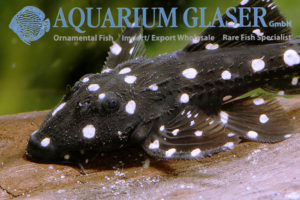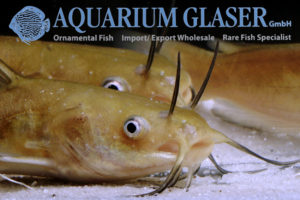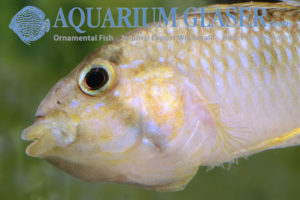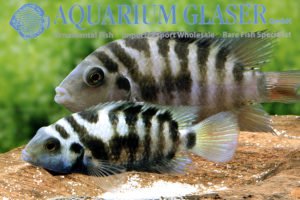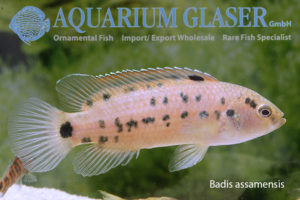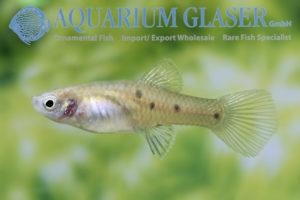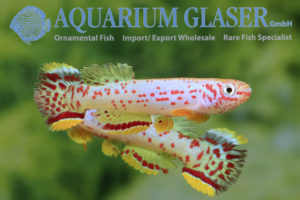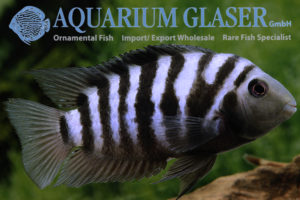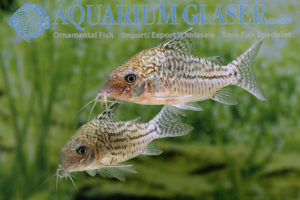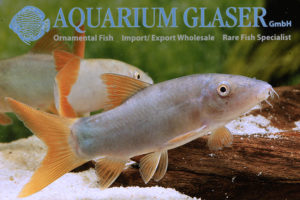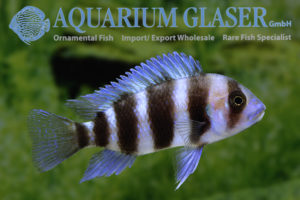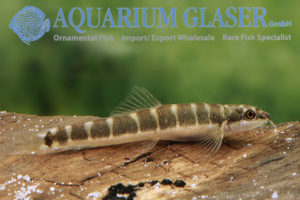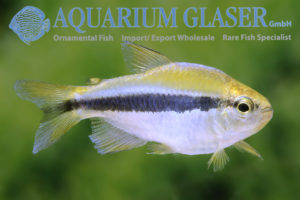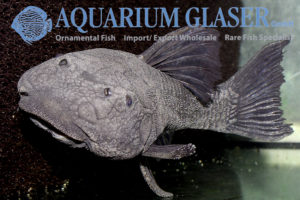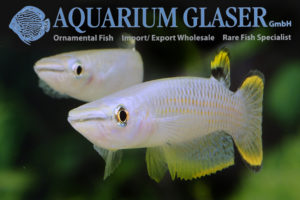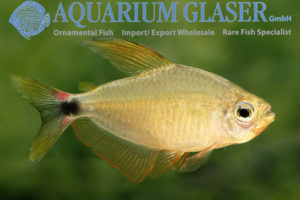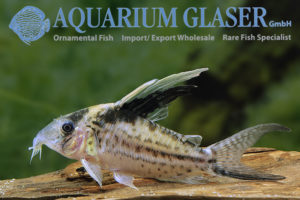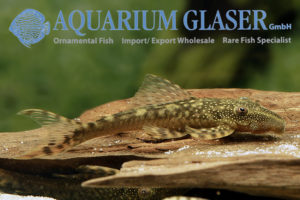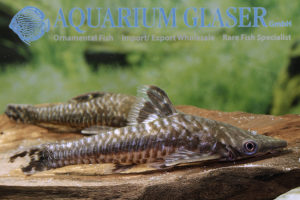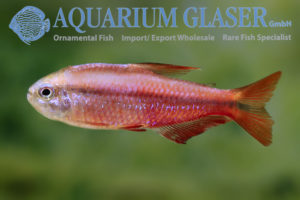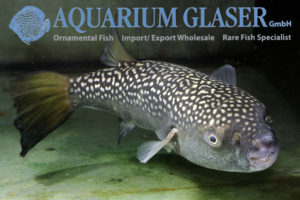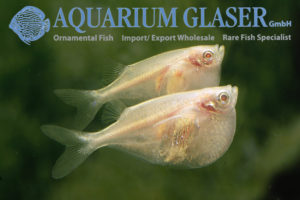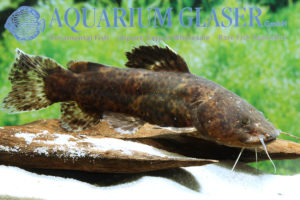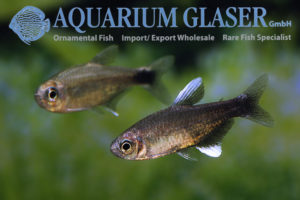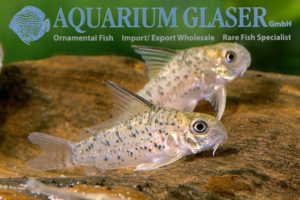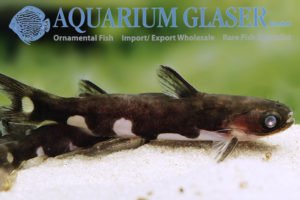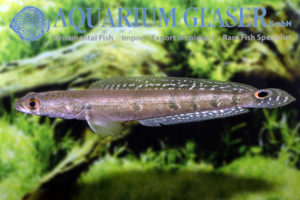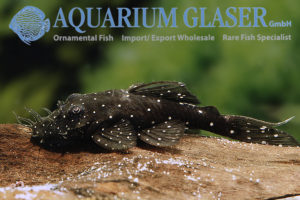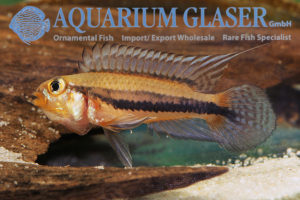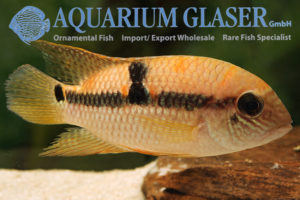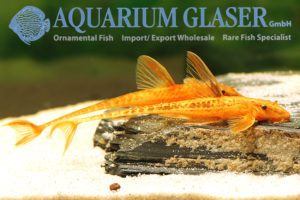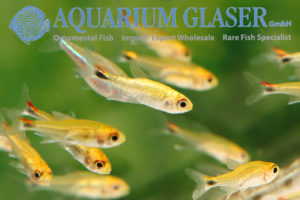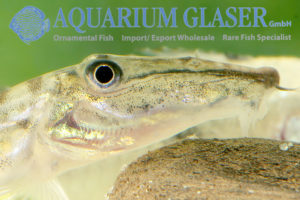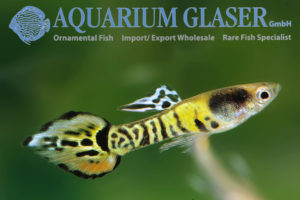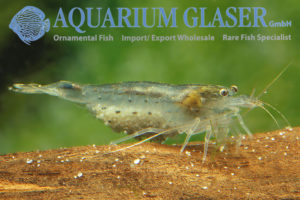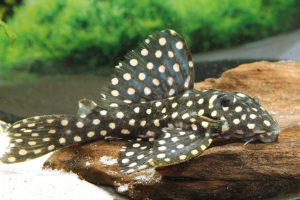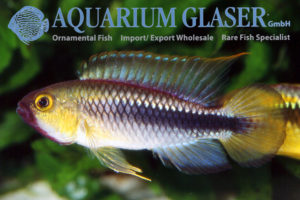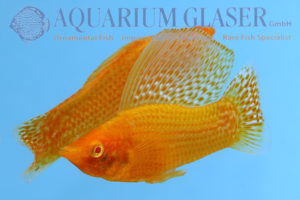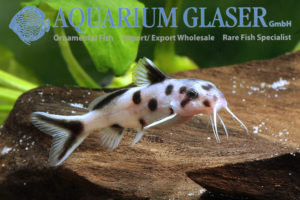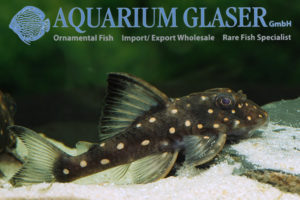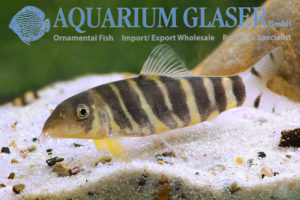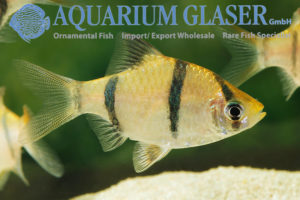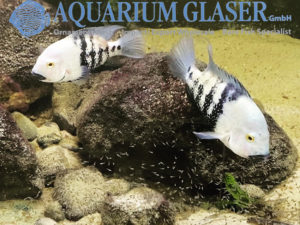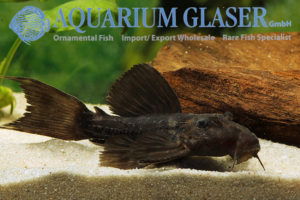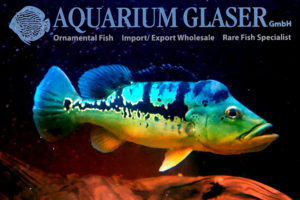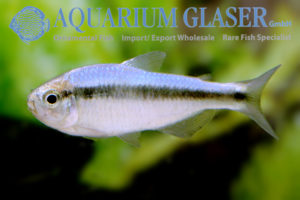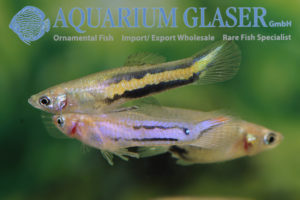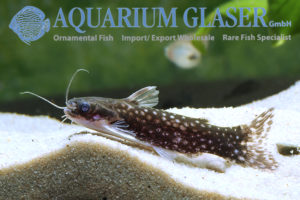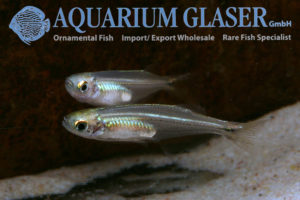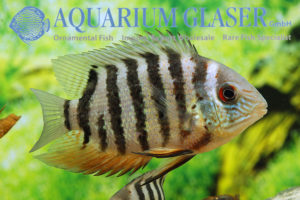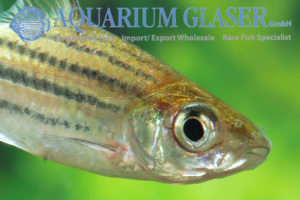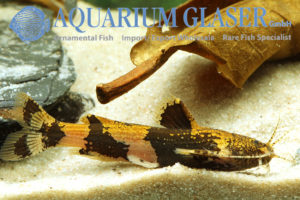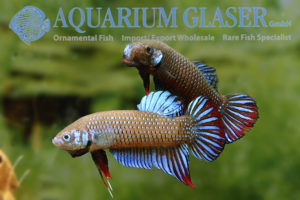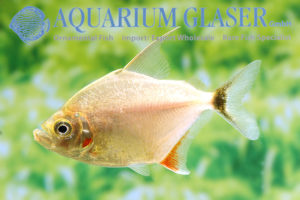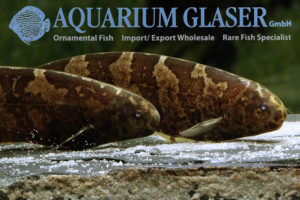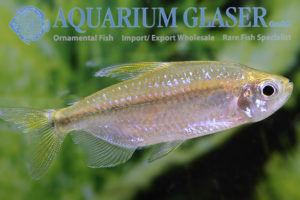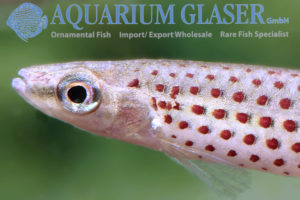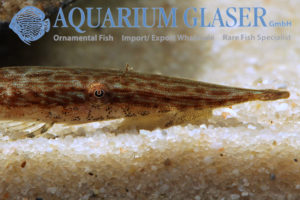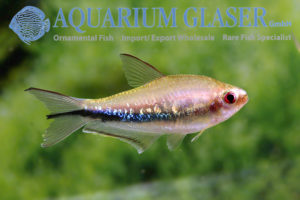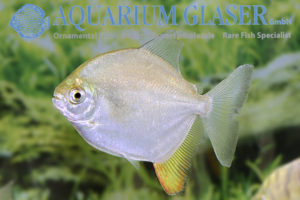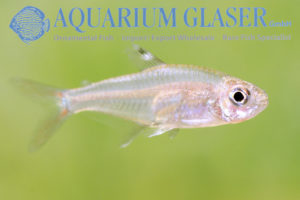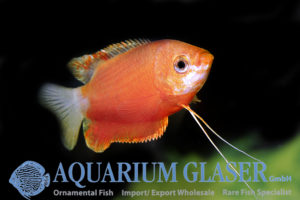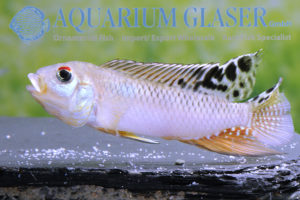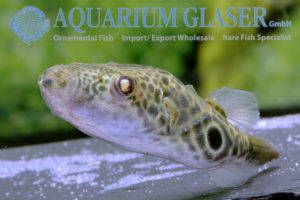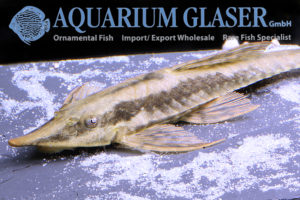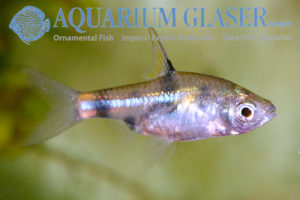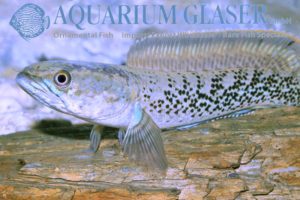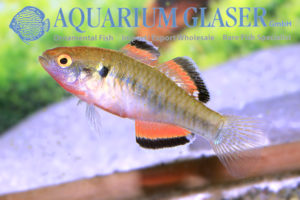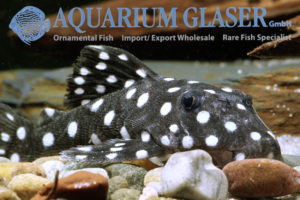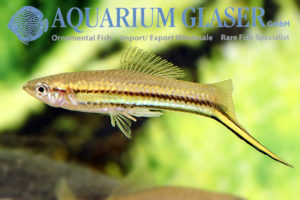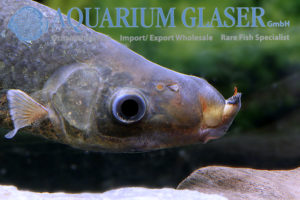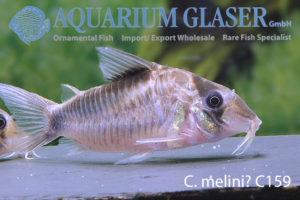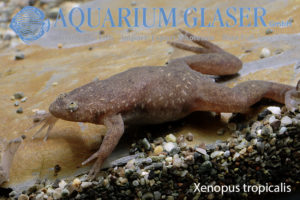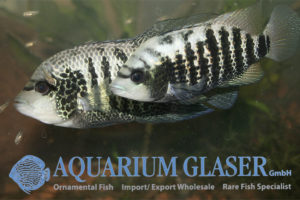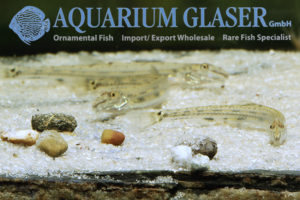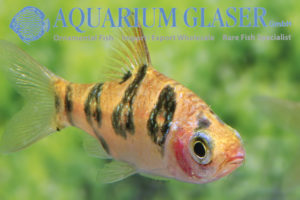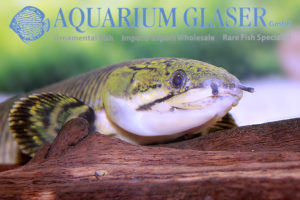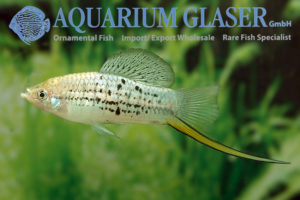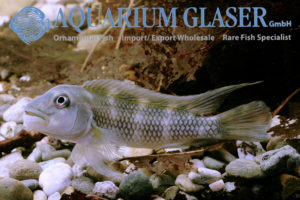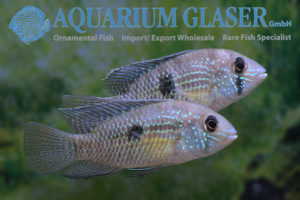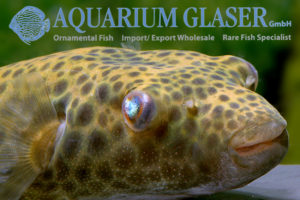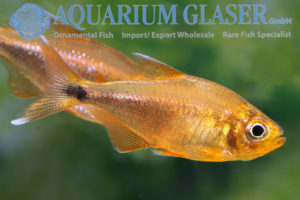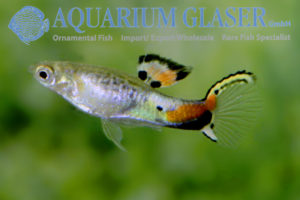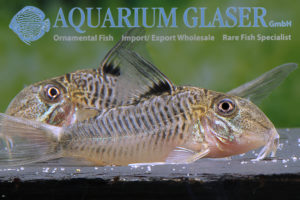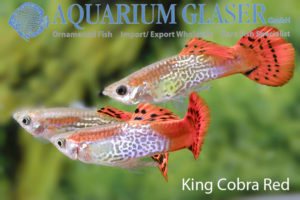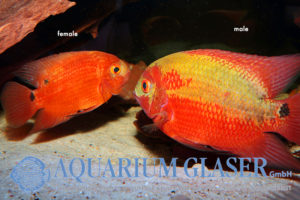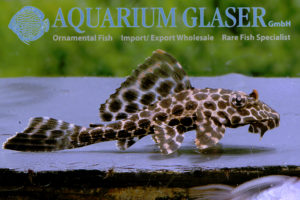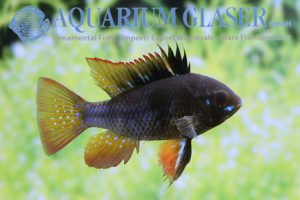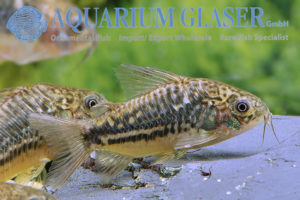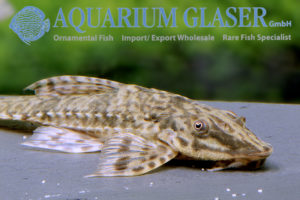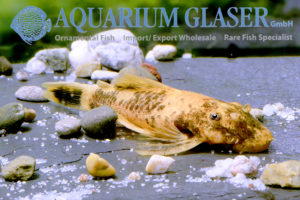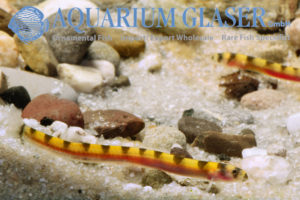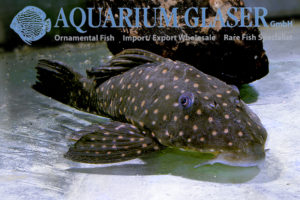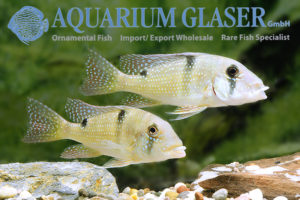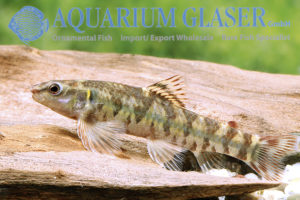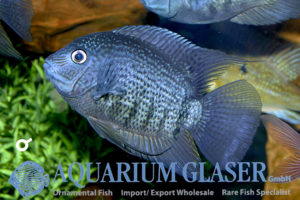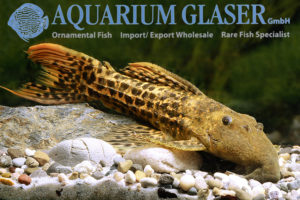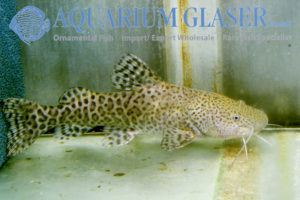Now it is season again for one of the most beautiful of all loricariid catfishes: Acanthicus adonis. The species name “adonis”, which is reminiscent of the ancient god of beauty and vegetation, Adonis, is aptly chosen. For like the god described as a beautiful youth, the Adonis catfish is such a beauty only when young. […]
Fish Archive (3096)
-
-
Ameiurus melas
Among the aquarium fishes that have been kept already in the 1890ies belong the two species of bullhead catfish Ameiurus melas and A. nebulosus. Both species are very similar to each other and even specialists have problems to tell them apart. Initially bullhead catfish were brought to Europe as foodfish in the 1880ies from the […]
-
Apistogramma barlowi (= sp. mouthbrooder)
The first reports about the brood care behavior of this dwarf cichlid in the early 2000s were a sensation. Mouthbrooding Apistogramma – one had never heard of it before. Later it turned out that things are complicated. Some of the females of A. barlowi, as this species is now called, show quite normal Apistogramma brood […]
-
Amatitlania siquia (= sp. Honduras Redpoint)
The taxonomic status of this small cichlid, which has had quite a respectable aquaristic career as Amatitlania sp. Honduras Redpoint, is controversial. It is currently assumed that it belongs to the species scientifically described as A. siquia. Now this species is itself controversial and is seen by some scientists as a synonym to the old […]
-
Badis assamensis and Badis blosyrus
In the north of India there are two Badis species, which are indistinguishable by color: B. blosyrus and B. assamensis. The only discernible difference that exists is the size of the mouth cleft. It is much larger in B. blosyrus and reaches below the center of the eye margin, whereas in B. assamensis the mouth […]
-
Phallichthys quadripunctatus
Unfortunately only very rarely we can offer this cute dwarf livebearer from Costa Rica. The males grow to a length of about 1.5 cm, the females to a maximum of twice this size. The species name “quadrimaculatus” refers to the typically four spots these fish have on their flanks. However, many variations also occur in […]
-
Fundulopanchax scheeli
Within the genus Fundulopanchax, which was established already in 1924, but then was seen as a synonym to Aphyosemion for a very long time, there are very large species, like F. sjostedti, which can reach 12 cm (see https://www.aquariumglaser.de/en/fish-archives/fundulopanchax_sjostedti_usa_blue_en/), but also many small species, which do not grow longer than 6 cm. Among the latter […]
-
Amatitlania nigrofasciata
Are you in a phase of the hobby, in which nothing at all wants to work out concerning breeding? Then it is time for the emergency rescuer in all situations, the convict cichlid Amatitlania nigrofasciata. Although it is no longer available everywhere and at any time, especially in its natural form, it hardly ever disappoints […]
-
Corydoras sodalis Colombia
Widespread species often show coloration differences in the different parts of the distribution area. So also the beautiful Corydoras sodalis, which is reported from Peru, Brazil and Colombia. From Colombia we could now import C. sodalis, which differ quite clearly in color and figure from e.g. animals imported from Brazil (see https://www.aquariumglaser.de/en/fish-archives/corydoras-sodalis-2/). For our customers: […]
-
Yasuhikotakia modesta (2)
One of the most beautiful and largest botias besides the well known and popular Chromobotia macracanthus is the Redtail botia Yasuhikotakia (formerly: Botia) modesta from Southeast Asia. These are gorgeous fish, usually with a very unusual dove blue base coloration that contrasts very nicely with the red fins. But there are also green, yellow-finned variants […]
-
Cyphotilapia frontosa
The humpheaded Frontosa (Cyphotilapia frontosa) from Lake Tanganyika has enjoyed great popularity for decades, although (or: because!) the species belongs to the bull class among the cichlids. Old males, which look downright bizarre with their forehead hump, can grow 30 cm long. Females generally remain smaller. In addition, C. frontosa is a crepuscular predator that […]
-
Schistura savona
What the Corydoras are in South America, the Schistura loaches are in Asia. In hundreds of species they populate practically every stream and smaller river of the tropical and subtropical regions of the continent. In many cases, identification is difficult or impossible. Not so with Schistura savona from India. Its “half band” pattern with white […]
-
Hyphessobrycon cyanotaenia – extra pretty wild catches
The tetra Hyphessobrycon cyanotaenia was originally imported as “Lapis-Tetra” from Brazil; that was more than 20 years ago (see https://www.aquariumglaser.de/en/?s=cyanotaenia). Since the breeding was successful this beautiful and easy to keep fish is now a common sight in the trade. The origin was mysterious for a long time, because the scientific description was based on […]
-
Rhinelepis cf. strigosa
The two species of the genus Rhinelepis – R. aspera and R. strigosa – belong with over 60 cm attainable final size to the largest armored catfishes at all and are therefore predestined as show objects in zoos, public aquariums and of course also for owners of gigantic private aquariums. Color-wise they have nothing to […]
-
Aplocheilus panchax
Because of the still bad flight connections imports from India come in only sporadically. Now once again an import worked out. It contained among others the common panchax, Aplocheilus panchax. A. panchax is the most common fish in large parts of India and can be found literally everywhere, from the smallest puddle to the shores […]
-
Hyphessobrycon procyon
One of the still very expensive tetra novelties in the aquarium is the very, very pretty Hyphessobrycon procyon from the Rio Aripuanã in the middle basin of the Rio Madeira. It looks confusingly similar to the kitty tetra, H. heliacus, at first glance. H. procyon and H. heliacus form a species complex together with the […]
-
Corydoras robustus
This Corydoras belongs with 9-11 cm of total-length to the biggest and most splendid species of the genus at all. Both sexes develop, when they are sexually active, long dorsal fins. The males can be recognized by the additional long ventral fins. At the moment we have wonderful, fully grown, well settled animals in stock. […]
-
L92/L194 Lasiancistrus tentaculatus
There seems to be a consensus among armored catfish enthusiasts that L92, which is very widespread in the Orinoco drainage of Colombia and Venezuela and later received another L-number, namely L194, is identical to Lasiancistrus tentaculatus, which was described in 2005. However, L. tentaculatus is described as more or less monochromatic brown, while L92 is […]
-
Hypoptopoma sp. Ucayali
From Peru we could import very nice Hypoptopoma. Most of the import consisted of H. gulare (see https://www.aquariumglaser.de/fischarchiv/hypoptopoma-gulare/), but there were some specimens with very conspicuous, broad bands in the dorsal fin and contrasting caudal fins. Unfortunately the identification attempt based on the current revision of the genus (Aquino & Schaefer, 2010) did not give […]
-
Hyphessobrycon notidanos “Red Devil
Hyphessobrycon notidanos from the upper drainage of the Rio Tapajós in Brazil, which was scientifically described only in 2006, is apparently a quite multicolored animal. So there is the “Red Devil” with much red in the body and blue iris and the “Yellow Devil” with red iris. Both color forms are said to occur together […]
-
Chelonodontops bengalensis
Large puffer fish are always a cause for joy among our staff. The animals are not only beautiful, but they communicate with the keeper and the hall visitors. Their eyes are always in lively motion and it is difficult to avoid the impression that the fish in the aquarium looks at the person outside the […]
-
Gasteropelecus sternicla Albino
Hatchetfishes are normally wild caught. They are very common, easy to transport and therefore a welcome addition to the sustainable ornamental fish fishery in Venezuela, Colombia, Peru and Brazil. This is also true for the “Common” Hatchetfish, Gasteropelecus sternicla. For general information on the species, please also see https://www.aquariumglaser.de/fischarchiv/ein-grosser-klassiker-gasteropelecus-sternicla/. For some years now, offspring of […]
-
Rasbora rubrodorsalis
From Thailand we just received once again the dwarfish brilliant redfin rasbora, Rasbora rubrodorsalis. This species was recognized as a distinct species only late, in 1997, although it is widely distributed in Southeast Asia (Laos, Cambodia, Thailand, Vietnam). It was formerly thought to be a juvenile form of the similar species Rasbora borapetensis. Unlike R. […]
-
Batrochoglanis sp. Venezuela
Something is happening with the South American bumblebee and frog catfishes! In former times they were assigned to the long-whiskered catfishes (Pimelodidae), today they are placed in an own family, the Pseudopimelodidae. Often in the trade are the striking yellow-black marked, only 3-8 cm large South American bumblebee catfishes (Microglanis, 23 species), and the similarly […]
-
Hyphessobrycon negodagua
At present the small tetras of South America experience a new boom. Numerous species have been and are being described scientifically. Thus also the ornamental fish collectors leave their beaten tracks and look for these animals, particularly since currently peppered prices are paid for the novelties. Naturally, such a thing only works for a short […]
-
Corydoras sp. “Ogawae” CW86 (cf. armatus)
Corydoras armatus is a rather distinctive cory from Peru. We have also received this beautiful species, which is notable for its particularly high dorsal fin, from Venezuela from time to time (see https://www.aquariumglaser.de/fischarchiv/corydoras_armatus_venezuela_de/). Geographically this all fits together well, the catching regions both belong to the upper drainage of the Amazon. However, there is a […]
-
Tatia musaica/ Centromochlus musaicus
When the first black and white “Tatia” appeared in the ornamental fish trade some years ago, they were celebrated as a sensation. (see https://www.aquariumglaser.de/en/fish-archives/centromochlus_sp_ninja_en/ and https://www.aquariumglaser.de/en/fish-archives/tatia_musaica_en/). We identified these fish, which originated in Brazil, as Tatia musaica. In 2017, a team of scientists published a study on Centromochlus species and described the species previously known […]
-
Channa marulioides
The largest and most splendid of all snakeheads belong to the relationship of Channa marulius. This species occurs in India and attains a maximum length of about 120 cm. The largest specimen ever collected is said to have had a length of 183 cm and a weight of 30 kg. But most often the fish […]
-
Ancistrus sp. L184 (= L107)
One of the most attractive Ancistrus species is this so far not scientifically identified species from the middle Rio Negro in Brazil. There the beautiful fish is not rare, in some places even very common, but the species apparently prefers biotopes which are avoided by the local fishermen; otherwise it can hardly be explained why […]
-
Apistogramma diplotaenia German bred
The double stripe (= the translation of the word diplotaenia) is still a rare occurrence in the aquarium. For successful breeding you have to reach pretty deep into the bag of tricks of water chemistry and the animals are also relatively unproductive. This unusual Apistogramma species originates from the black water of the Rio Negro, […]
-
Aequidens superomaculatum
For the first time we were able to import a beautiful Aequidens from Venezuela, which is probably Ae. superomaculatum. This species has been described scientifically only a few years ago – in 2015. Unique in the genus and also giving the name (superomaculatum = with a spot above) is the combination of a continuous lateral […]
-
Rineloricaria lanceolata “Red Dun“
For the first time we can offer the breeding form “Red Dun” of the Chocolate Whiptail Catfish. This new breeding form goes back to a wild-caught male that we were able to import from Paraguay in November 2015 (see https://www.aquariumglaser.de/en/fish-archives/rineloricaria_lanceolata_en/). We gave it, together with some normal females of the same import, to our breeder […]
-
Axelrodia stigmatias
This cute dwarf tetra was described in 1913 from the Rio Madeira, where it was collected near Porto Velho. It is a typical companion fish of the two neon species Paracheirodon axelrodi and P. simulans and, as we know today, occurs throughout the range of the two neons, i.e. in the upper Orinoco and the […]
-
Acantopsis dialuzona
In the last years we received horseface loaches (Acantopsis) mainly from Thailand, where the genus is represented by several species, which are difficult to distinguish. Now we have once again received specimens from Indonesia. It is A. dialuzona, the best known species of the genus by name. In older aquarium books this species can be […]
-
Guppy Endler “Bengal Tiger”
The tiger breeding forms of the Endler guppy enjoy special popularity. There are multicolour, blue and also selected for yellow body color strains. The latter is called “Bengal Tiger”. The manifestation of pure yellow animals is not easy, there is a tendency to revert to a gray-blue base coloration. But these are also very pretty […]
-
Amano shrimp now also available as German offspring
The Amano shrimp (Caridina multidentata, formerly known as C. japonica) is one of the most popular freshwater shrimp for the aquarium. It feeds on Aufwuchs, eg microorganisms and is therefore absolutely harmless to fish and plants. Instead, through its grazing activity, it frees plants and decoration from annoying algae growth or ensures that algae do […]
-
Hypancistrus contradens L201a Big Spots
From the lower Rio Ventuari in Venezuela – the largest tributary of the Orinoco – as well as from the Orinoco itself in the Ventuari estuary comes a beautiful Hypancistrus. It has large, bright spots on a deep black ground. The coloration of the spots is varying between shy white and orange-pink. There is a […]
-
Apistogramma sp. Wilhelmi
More than 20 years ago (1999) Mario Wilhelm brought back from an expedition to Brazil for the first time this beautiful dwarf cichlid from the Rio Abacaxis. An alternative name to Apistogramma sp. Wilhelmi is therefore A. sp. Abacaxis. This river, a well known area for discus fishes, belongs to the drainage of the Rio […]
-
Poecilia velifera Blood Red
The golden albino breeding form of the sailfin molly (Poecilia velifera) was created in the early 1980s. At that time it was celebrated as a sensation. Nowadays it is one of the most popular breeding forms of this molly. Particularly color-intensive golden sailfin mollies are called “Blood Red”. These animals are currently brought to the […]
-
Synodontis polli “White”
Some time ago a small Synodontis appeared in the hobby, which is called “White Polli”. But the “White” has little in common with the actual Synodontis polli. The dorsal fin spine of “White” is bicolor, black in the lower half, white in the upper half. This species is distributed in the hobby almost exclusively as […]
-
L501 Hypanacistrus sp. Mitu
Snowball plecos belong to the largest Hypancistrus species. They can reach up to 20 cm in length. Members of the group are easily recognized by the conspicuous black fringes in the dorsal and caudal fins. Distinguishing the aquaristically known form, on the other hand, is tricky and sometimes simply impossible without knowledge of the origin. […]
-
Botia dario
Now is the season for the very beautiful and relatively small remaining loach Botia dario from India. Usually the species grows to a length of 6-8 cm, as record size 15 cm are given in literature, but it is not clear if this is not a case of confusion. In India and adjacent countries the […]
-
Puntigrus tetrazona – the true tiger barb
We have now been able to import genuine tiger barbs from Central Sumatra (Jambi Province) as wild-caught specimens. When looking at the pretty and extremely lively animals, it is immediately clear that it is something other than the “aquarium tiger barb”. We are very happy that we succeeded in importing this “real” tiger barb, eg […]
-
Astatheros macracanthus (formerly: Cichlasoma m.)
There is no doubt that Astatheros macracanthus is a fish for connoisseurs. This 20-25 cm long cichlid is distributed quite widely from southern North America to Guatemala and El Salvador. The species was scientifically described already in 1864, but in the aquarium it has always remained an absolute rarity. The reason is clear: in the […]
-
Pseudacanthicus sp. L185 Bred
The cactus plecos (Pseudacanthicus) are popular with owners of large aquariums. L185 originates from the Rio Xingu and is also called Belo Monte Cactus Pleco, because this catfish used to be caught there. We do not know if the species still exists there, or if it was wiped out by the construction of the Belo […]
-
Cichla ocellaris x melaniae Hybrid
Few fish show as clearly how dynamic things can get in aquaristics as Cichla. These large cichlids are among the most popular food fish in South America, but until the turn of the millennium they were not considered very suitable for aquarium care: they were considered too large and too sensitive. In the meantime, however, […]
-
Hyphessobrycon melanostichos
At the moment we can offer magnificent, fully grown bred specimens of Hyphessobrycon melanostichos. Hyphessobrycon melanostichos is very eye-catching due to its bright sky-blue back coloration. The species was scientifically described in 2006 from the Brazilian state of Mato Grosso, where it occurs in the upper drainage of the Rio Tapajós. The species is distinguished […]
-
Micropoecilia parae German Bred
Micropoecilia parae belongs to the very few fish species, whose breeding in the aquarium over numerous generations has not succeeded so far. Basically the reproduction of the viviparous fish is not difficult, but from generation to generation the animals become smaller and smaller, until finally no further breeding is possible, because the fish die before […]
-
Tatia galaxias
The cute Tatia catfishes are quite popular in the hobby. Keepers put up with the fact that you can hardly see them outside feeding times, because they are extremely addicted to hiding. But they make up for it with their pretty coloration and good breedability. Tatia galaxias comes from the Orinoco river basin in Colombia […]
-
Denticeps clupeoides
Herring can usually only be kept in the aquarium with enormous effort; moreover, most species live in the sea. Denticeps clupeoides is a small freshwater herring, it grows to a maximum length of 15 cm, but specimens over 8 cm in length are very rarely encountered. It lives in larger shoals near the surface in […]
-
Heros sp. Curare Bred
For the first time we could import this magnificent Heros from Venezuela in 2016. The animals should originate from a Rio Curare, therefore the name; however, no Rio Curare is known to us. We suspect the Rio Ventuari as origin. The fish are extremely colorful, otherwise everything speaks for the fact that it concerns the […]
-
Striuntius lineatus
Only in very few cases is such confusion around fish names as there is around the horizontically striped barbels of Southeast Asia. The beautiful animals belong according to current opinion to two genera: the species with clearly visible, long barbels belong to the genus Desmopuntius with currently seven accepted species and the form without (or […]
-
Akysis prashadi
The range of small, peaceful catfishes from Asia is much smaller than from South America, but they do exist. Moth catfishes (Hara, Erethistes) for low flow aquariums and wasp catfishes (Akysis) for tanks with more flow are becoming increasingly popular. Akysis get their name “wasp catfish” from the most famous species, Akysis vespa, whose sting […]
-
Betta imbellis
For many Betta imbellis is the prettiest wild fighting fish at all. Of course, “the” Betta imbellis does not exist at all, because the widespread species looks somewhat different everywhere. It is the sister species to Betta splendens and in fact no human being is able to distinguish completely decolorized specimens of both species from […]
-
Catoprion mento
Finally we managed to import Wimple Piranhas (Catoprion mento) once again. In nature C. mento is a scale eater – at least at certain times. In terms of feeding, right now is a good time of year because there are plenty of live white mosquito larvae now, which are an ideal food for Wimple Piranhas. […]
-
Steatogenys duidae
From Peru we have received exceptionally nice knifefishes of the species Steatogenys duidae. According to current knowledge the genus Steatogenys comprises three species, all of which have zebra-like stripes. With a final length of about 20 cm they remain comparatively small, only S. ocellatus grows significantly larger at 30 cm. The three species are very […]
-
Phenacogrammus cf. taeniatus
A new fashion trend in the hobby is emerging: tetras from the Congo! The region was already often in the focus of the hobby, but it was about killifishes or cichlids. The large flock of silver glittering open water species was of less interest. With the discovery of the unbelievably colorful Phenacogrammus sp. “Fantastique” (in […]
-
Copella meinkeni
These beautiful tetras were called Copella nattereri in literature for many years until a scientific study found that C. nattereri is in fact the species previously known as C. nigrofasciata and that the “C. nattereri” from the Orinoco and Rio Negro belong to a scientifically unnamed species called Copella meinkeni. We regularly offer this attractive […]
-
Acestridium dichromum
The strange sucking catfishes of the genus Acestridium – there are currently seven recognized species in the genus – could also be called “dwarf needle catfishes”, because they look like a miniature version of the needle catfishes of the genus Farlowella. Unfortunately, these animals are still an aquaristic challenge, which only very experienced aquarists should […]
-
Nematobrycon lacortei
The Rainbow Emperor Tetra (Nematobrycon lacortei) is certainly one of the most attractive tetras in South America. Its home is in western Colombia where it is caught in the catchment area of the Rio San Juan. Males and females can be easily distinguished by the color of the iris. Already in small juveniles the males […]
-
Myloplus torquatus
From Venezuela we received very nice Myloplus torquatus. The up to approx. 25 cm long species is scientifically known for a very long time (since 1858) and in the course of time it was already assigned to the genera Myletes and Myleus. A very good recognition feature is the black fringe in the caudal fin, […]
-
Hyphessobrycon dorsalis
Tetras, which – as Hans-Georg Evers so aptly put it – are magnificently white wine colored, have a hard time in aquarists. In the dealer’s tank there is usually nothing to be seen of the discreet colors and why, many ask, should one buy colorless fish when there are so many colorful species? This opinion […]
-
Colisa labiosa Ruby Red
Besides the orange colored breeding form of this gourami from Burma (see https://www.aquariumglaser.de/en/fish-archives/colisa-labiosa-orange-2/) there is also a very attractive, deep red colored breeding form. In order to keep these wonderful animals in their bright coloration permanently, it is necessary to provide certain types of food (e.g. Cyclops, Spirulina or also special flake food). Without the […]
-
Nanochromis cf. teugelsi
We have received beautiful offspring specimens of this magnificent Nanochromis from the Congo. Since the experts are not yet agreed whether this species is a color variant of Nanochromis teugelsi or a different species, we have chosen the name Nanochromis cf. teugelsi. The beautiful dwarf cichlids reach a length of about 7 cm in the […]
-
Pao sp. Chao Phraya
The cockade pufferfishes are a very complex group of freshwater pufferfishes. Formerly they were called the “Tetraodon-leiurus group”, but since 2013 they are in the genus Pao. The genus name Tetraodon is now only applied to the freshwater puffers of Africa. Throughout Southeast Asia (Thailand, Laos, Cambodia, Vietnam, Malaysia, Singapore, Indonesia), Pao freshwater puffers can […]
-
The sturgeon catfishes of Paraguay: Sturisoma barbatum or S. robustum?
From Paraguay wonderful, partly very large sturgeon catfishes (Sturisoma) are imported. Two Sturisoma species are known from the Rio Paraguay: S. barbatum, described already in 1853 by Kner, and S. robustum, described in 1904 by Regan. The two species differ from each other only insignificantly. The most important anatomical feature distinguishing the two species is […]
-
Pethia gelius
The golden barb (Pethia gelius) is an aquarium old-timer that found friends even before the First World War. It is one of the smallest barb species in India. Males rarely grow longer than 2.5 cm, females slightly larger. The record of 5 cm total length, which has been haunting the literature for decades, is probably […]
-
Channa stewartii
This snakehead, often traded under the name Channa cf. barca, originates from the northern Indian province of Assam. C. stewartii can reach a length of up to 30 cm (usually around 20 cm) and as a predatory fish should only be kept along with fish that are at least 2/3 of its body length. Besides […]
-
Hypseleotris compressa
Sometimes it happens that even we run short in finding superlatives: in any case this fish deserves to create one! It is so beautiful…. H. compressa is a sleeper goby that lives free swimming in the water column. In contrast to many other gobies this fish is not a bottom dweller. In Germany the genus […]
-
Baryancistrus sp. Snowflake LDA 33 / L142
This beautiful loricariid catfish comes from the Rio Tapajós in Brazil. Usually, 4-5 cm long youngsters are imported from these catfishes, which look very attractive with their large, white dots on a deep black ground and fully deserve the name “Snowball-Pleco”. In addition to high water temperatures (not below 28°C), these catfishes should be kept […]
-
Xiphophorus hellerii “Jalapa”
When you first see this slender, splendidly colored swordtail wild form, you involuntarily think: this is no X. hellerii! And yet, when X. hellerii was first described in 1848, exactly such animals became the type specimens. The traveler of the royal imperial horticultural society Karl Heller discovered and collected the animals in clear streams of […]
-
Sartor respectus
From the Rio Xingu we could import the probably strangest of all headstander: Sartor respectus. Unfortunately there were only two specimens, which one of our employees acquired. Nevertheless we did not want to withhold this speciality from you, dear readers. Sartor (there are two other very similar species, one from the Rio Trombetas (S. elongatus) […]
-
The “real” Corydoras melini?
One of the most important arguments for importing wild-caught fish for aquaristics is the gain in knowledge it allows. For the majority of small fish species this is only possible by observing living specimens. Without this there is no species knowledge, without species knowledge there is no species conservation. A wonderful example of the above […]
-
Xenopus tropicalis
Most likely, the trade of clawed frogs of the species Xenopus laevis will soon be banned because a reproducing population has been discovered in France. Due to climate change, it is now feared that this species could become invasive in Europe. To prevent this, the trade with this species should be prohibited. We would like […]
-
Mayaheros beani (formerly: Cichlasoma b.)
Origin: Rio San Christobal = Laguna El Camalote, San Blas, Nayarit, Mexico The small town of San Blas, where the Rio San Christobal empties into the Pacific Ocean, is considered the northernmost place with a tropical climate on the Pacific coast of Mexico. The name Laguna El Camalote was originally applied to a marshland southeast […]
-
Acanthopsoides robertsi
Horseface loaches (Acantopsis) are popular and well-known aquarium fishes, but with 15-20 cm attainable final length (the record is even 25 cm) they become quite large and therefore need larger aquariums. Practically unknown to aquarists are the dwarf horseface loaches (Acanthopsoides), whose seven species grow to only 3.5-5.5 cm in length. The photographed specimens are […]
-
Desmopuntius rhomboocellatus
Once again we have been able to import beautiful, fully grown specimens of the Orange Barb; unfortunately they are already sold out, but we want to use this opportunity to point out another of the numerous name changes of the Asian small barbs. Desmopuntius – the name means “convict barb” and refers to the striped […]
-
Polypterus mokelembembe
Bichirs are so called living fossils. Already 60 million years old fossils were found, which can still be assigned to living species today. However, there are only 16 known species, all coming from Africa. The last discovered and at the same time smallest species of the genus is Polypterus mokelembembe, which was described as a […]
-
Xiphophorus nezahualcoyotl
We have just obtained very attractive offspring of the “Northern Mountain Swordtail”. The fish are young adults, i.e. the sword of the males is still relatively short. For comparison we show here also an adult pair of another strain. In former times X. nezahualcoyotl was considered as a local variant of X. montezumae. The name […]
-
The global ornamental fish trade in times of Corona
The ornamental fish industry, as an international, global player, is naturally particularly affected by the pandemic; however, it is not only the virus and its direct effects that are causing problems for breeders, catchers and exporters around the world. Climatic changes, industrial conversion of the landscape, water pollution and social aspects also have a major […]
-
Steatocranus gibbiceps
Our current Congo import contains again two species of the funny humphead cichlids: Steatocranus casuarius and S. gibbiceps. They look very similar to each other at first sight (and we can hardly avoid in wholesale that sometimes a casuarius is among the gibbiceps and vize versa), but when looking closely you can see that in […]
-
Andinoacara latifrons Rio Atrato
This beautiful cichlid has been swimming in the world’s aquariums since 1906 and has been delighting for generations with its varied behavior and beautiful looking brood care. The animals are typical open breeders with parent family, i.e. both parents lead the numerous brood. Confusion gave in the course of time due naming. For a long […]
-
Pao abei (formerly: Tetraodon or Monotrete abei)
In Southeast Asia a group of freshwater puffers exists that is extremely difficult to tell apart on a specific level. They are called the Eyespot-Puffers or the Pao-leiurus-complex. These puffers live in streams and rivers, some also in ponds and lakes, always in pure freshwater. Among the most enigmatic species is Pao abei, which has […]
-
Hyphessobrycon moniliger
Under the name “Hasemania hansseni” a new tetra has recently appeared on the market, which with its intense orange coloration is indeed somewhat reminiscent of the well-known copper tetra, Hasamania nana. However, one of the characteristics of the genus Hasemania is that it lacks the adipose fin that is so typical for tetras. This is […]
-
Poecilia wingei Campoma No31 Snake Blue
Infinite is the variety of colors, patterns and color combinations possible in wild guppys. In natural biotopes no two males are alike. There are multiple mechanisms, genetic and biological, that ensure this. This is also true for the two wild guppy populations assigned to the species Poecilia wingei: Campoma and Cuminá. However, if individual males […]
-
Corydoras geoffroy
For a long time this fish, the type species of the genus Corydoras, was a mystery. Until today it is a top rarity among the armored catfishes. And so we are especially pleased to be able to offer offspring of this precious fish once again. The animals are still a bit inconspicuous, so we would […]
-
Filigran Guppys – King Cobra Guppys
The Filigran Guppys belong to the most popular Guppy forms. They have a body pattern of squiggles and dots, which is also called “Snakeskin” or King Cobra. This body pattern sometimes appears in wild Guppys, but it was not until the 1950s that it received more attention and was genetically characterized by M. Dzwillo in […]
-
Hypselecara temporalis OYAPOC
The Emerald cichlid has become a bit out of fashion. This is a quite sad thing, for this impressive large cichlid – males can become up to 30 cm long, females always stay much smaller – is one of the most beautiful species of cichlid of South America. Once more we can offer now German […]
-
Glyptoperichthys gibbiceps
The red highfin sucker is a classic, which found its lovers long before the invention of the L-numbers. Juveniles are really adorable and excellent algae killers. In addition they look very beautiful. Since this catfish easily grows to 30-40 cm in length, there are two camps among aquarists. Some are critical of the animal because […]
-
Mikrogeophagus ramirezi “Black”
Black butterfly cichlids have been around for a few years and many breeders do an excellent job on them, so that really beautiful and healthy animals come on the market. We have now received a strain of Black Rams, in which the blue of the scales is limited to the rear half of the body […]
-
Corydoras undulatus Paraguay
The beautiful Corydoras undulatus belongs to the relationship of C. elegans. Like most representatives of this group the species swims rather in free water than on the ground. Also typical for the group is that males and females differ clearly in color. In the case of C. undulatus the males become very dark with bright […]
-
Rineloricaria parva
From Paraguay we regularly receive shipments of the small whiptail catfishes of the genus Rineloricaria. No less than 65 species are currently recognized, which makes identification in many cases almost impossible without knowledge of their origin. But in the case of Paraguay, there is a recent revision of the species known from this river system […]
-
Ancistrus Orange Brown “LDA16”
This extremely attractive Ancistrus is a breeding form. The actual LDA 16 is a wild form imported in 1994 from Brazil (Rio Puraqequara, a tributary of the Rio Guamá, which in turn is a tributary of the Rio Tocantins) and is uniformly purple-brown in color. We do not know if the orange-blotched Ancistrus descended from […]
-
Pangio cuneovirgata
Usually the different species of banded Coolie loaches (Pangio kuhlii, P. semicincta, P. myersi, P. shelfordi, P. alternans, P. cuneovirgata, P. malayana) are not distinguished in the trade because they are so variable in color and are often imported mixed. The sorting of Coolie loach is an activity you don’t want your worst enemy to […]
-
Hypostomus roseopunctatus L311
Not less than 148 species are counted to the genus Hypostomus, but no five of them appear more often in the trade. Special is of course H. luteus with its sail-like dorsal fin and the bright yellow coloration, but most species are “plecos”, brown or gray with black spots. In addition, most species grow quite […]
-
Geophagus harreri
In very small numbers we have received this beautiful Geophagus as German offspring. The species reaches a maximum length of 20-25 cm and is exclusively found in the inlet of the Marowijne River, the border river between French Guyana and Suriname. One of the tributaries of the Marowijne is the Maroni River, known to cichlid […]
-
Characidium fasciatum (C. cf. pterostictum, P. sp. V)
The South American darters of the genus Characidium are unfortunately almost indeterminable. There is no current revision of the 95 described species, but additional species are constantly being described and it is known that there are still numerous scientifically unrecorded species. In aquaristics one therefore helps oneself by simply calling everything “Characidium fasciatum”, well knowing […]
-
Heros sp. Madeira
The Rio Madeira is a right tributary of the Amazon River and is considered the largest tributary in the world. Its origin is in Bolivia where it is formed from the confluence of the Rio Beni and the Rio Marmoré. It flows into the Amazon in Brazil at Itacoatiara. The Rio Madeira is a white […]
-
Pseudacanthicus sp. L273 Titanic
The magnificent cactus catfish L273 Titanic, up to 30 cm long, originates from the Rio Tapajós. Its first import in 1998 was a sensation. Interesting about the animals, which are allowed to be exported from Brazil again since some time, is the very individual body pattern. All cactus catfishes are carnivores; towards non-species fishes they […]
-
Zungaro zungaro
The catfish Zungaro zungaro belongs to the largest catfish species of South America. There were all kinds of debates about its name, for a long time it sailed under Pseudopimelodus zungaro or Paulicea luetkeni. Because of its gigantic size (length up to 140 cm, weight up to 50 kg) the species is difficult to study […]
- « Previous Page
- 1
- …
- 6
- 7
- 8
- 9
- 10
- …
- 31
- Next Page »





